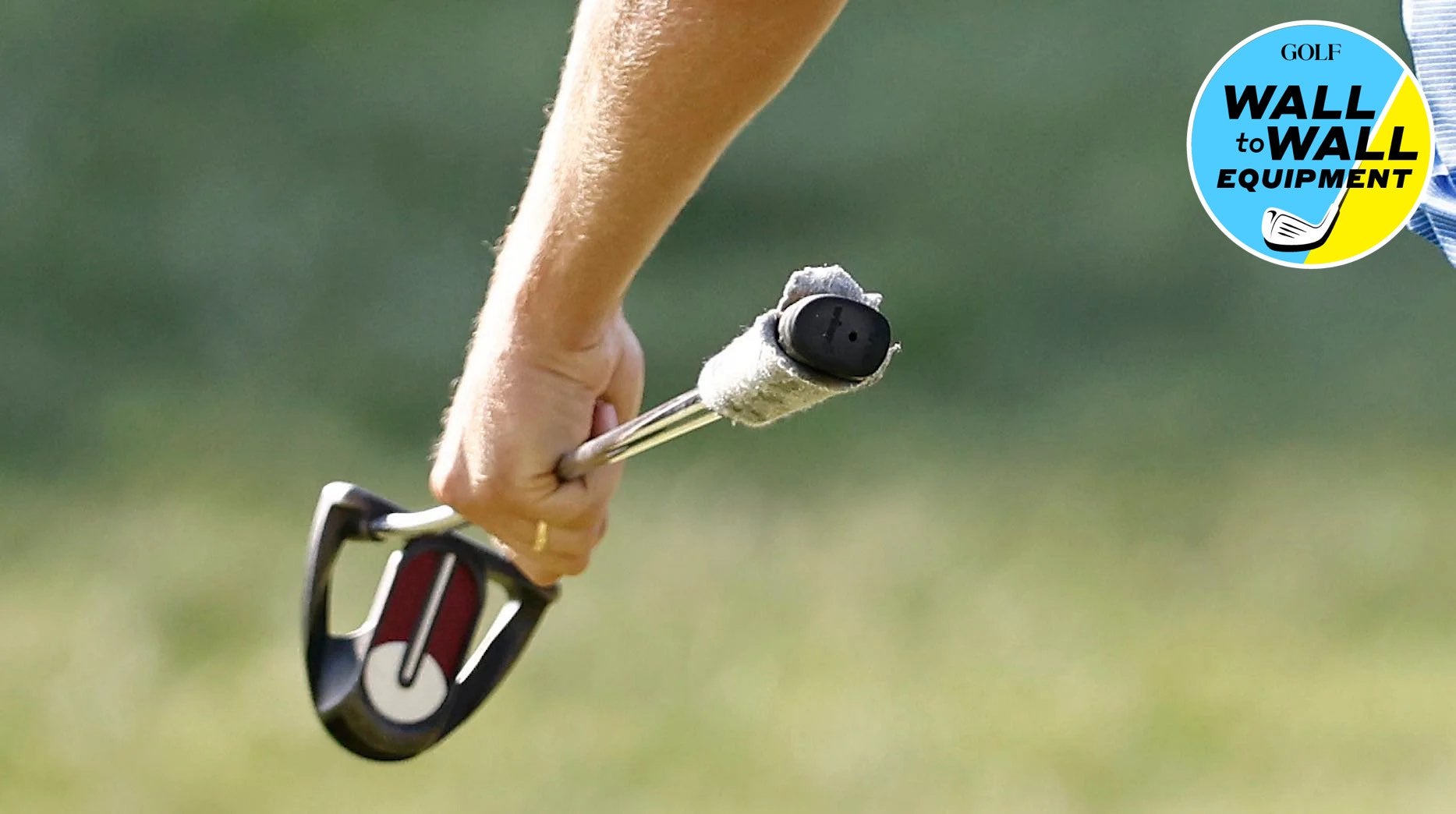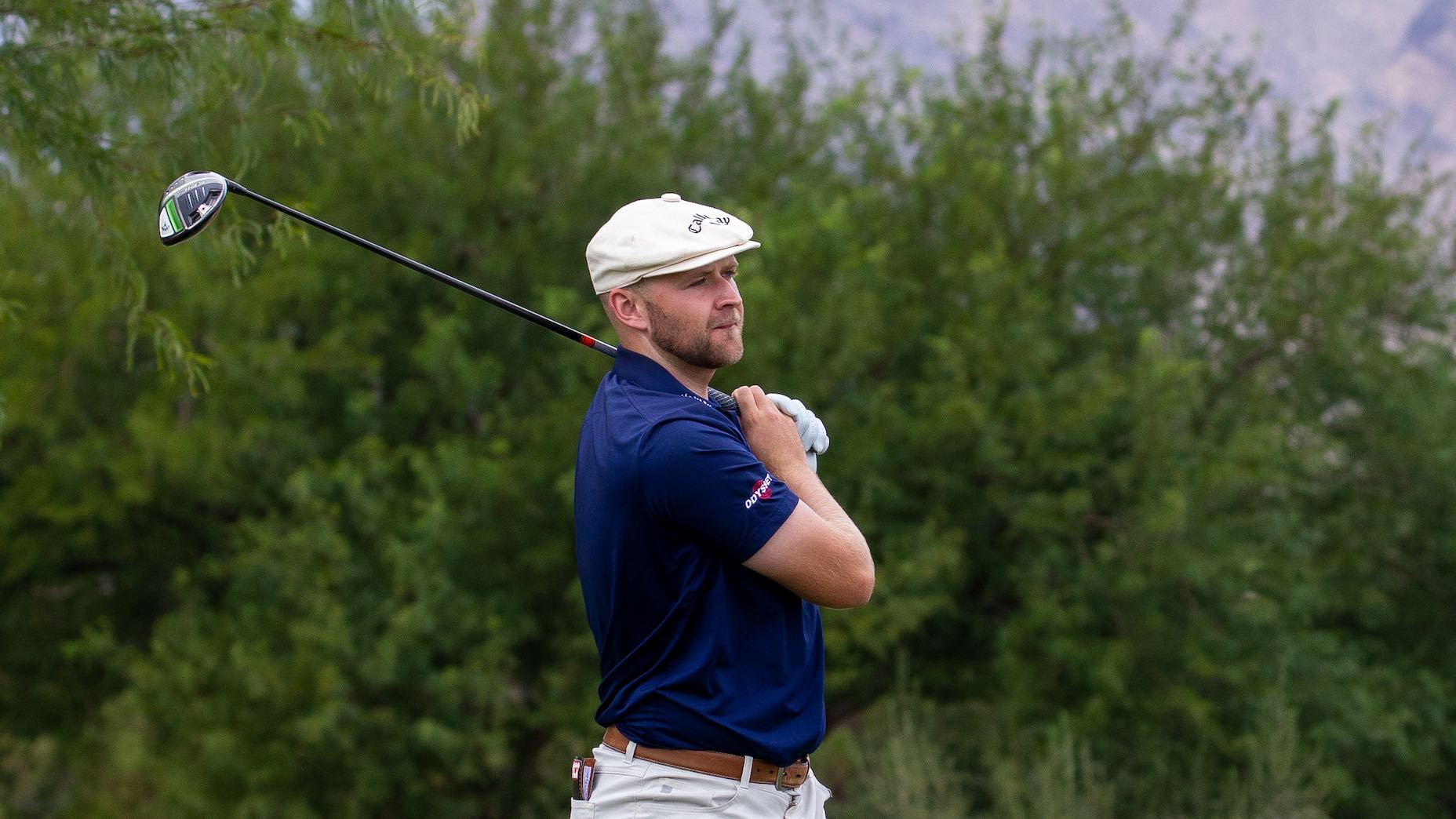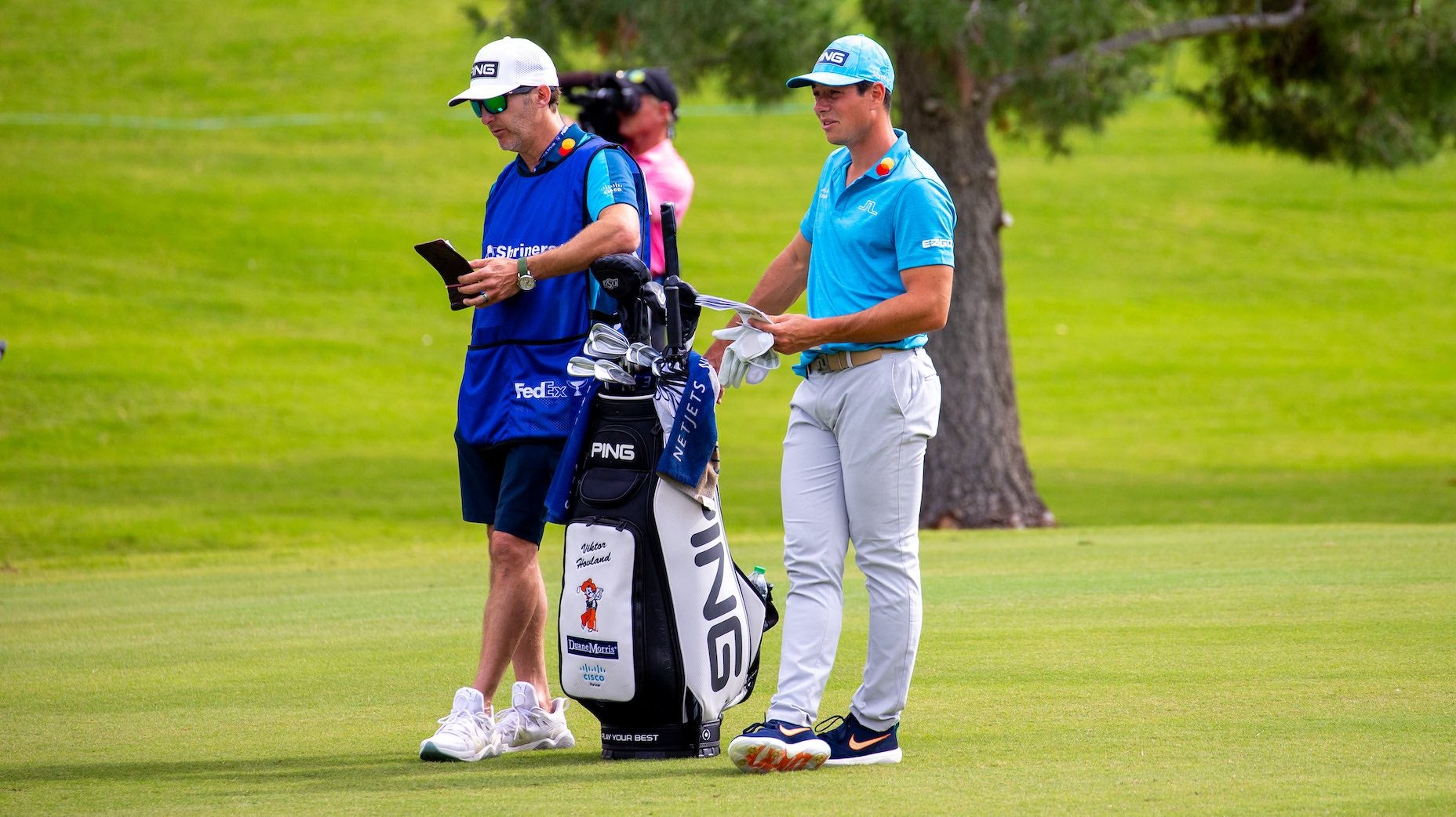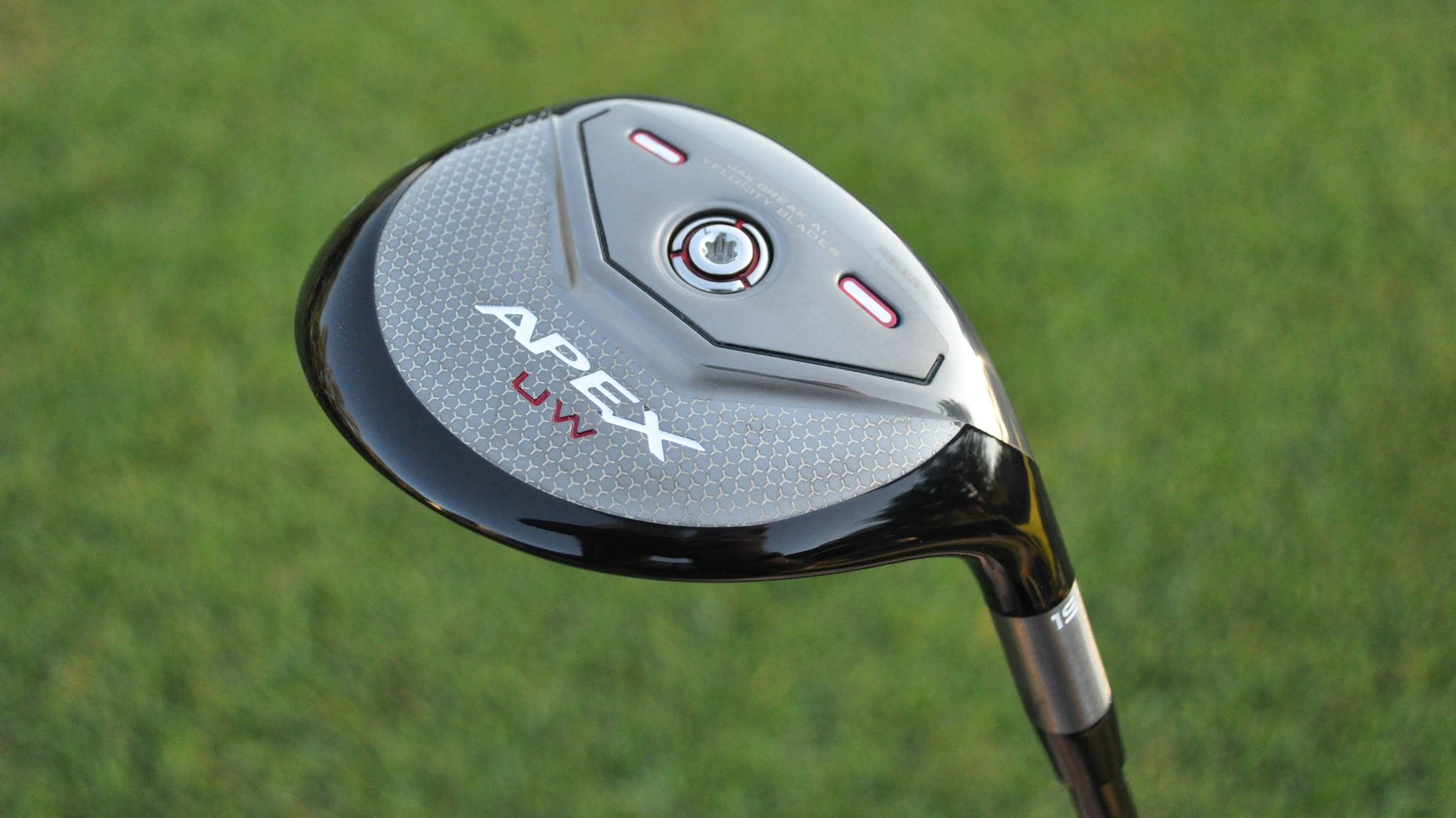
Ping helped bring Harris English’s putter grip back to life.
Getty Images
Welcome to Wall-to-Wall Equipment, the Monday morning gear wrap-up in which GOLF equipment editor Jonathan Wall takes you through the latest trends, rumors and breaking news.
Back from the dead
For about 5 minutes on Monday afternoon, Harris English figured his trusty, well-worn Ping Palm Lock putter grip would have to be put out to pasture. A couple weeks prior to teeing it up in Las Vegas, English was informed by Ryder Cup officials that the grip affixed to his Ping Hohum putter was non-conforming and would need last-minute surgery before his singles match against Lee Westwood.
Davis Love III came to the rescue in a pinch, but even English admitted the grip would likely need to be replaced.
“I thought I’d have to put a new grip on before Sunday’s round, which I was not pumped about,” he told the Fore the People podcast. “Luckily they allowed this, but I’ll probably have to put a new grip on pretty soon.”
In between shots, English continued to monitor a conversation between Ping Tour rep Kenton Oates, English’s coach Justin Parsons and PGA Tour rule official John Munch.
“[Harris] was really defeated on Monday,” Oates told GOLF.com. “We kept asking John questions for about 20 minutes to determine if there was a way to save the grip. Harris initially thought it was over, but you could tell he started to believe it could be salvaged.”
When you’ve won more than $20 million with the same putter and grip, every conceivable option is on the table.
“The reason [the grip] wasn’t conforming was that it wasn’t the same uniform thickness up and down the handle,” Oates said. “And that grip, unbeknownst to us, has a bunch of rubber layers before it gets to the core of the grip — and those rubber layers were fraying.”
After conversing with Munch, Oates and the rest of Ping’s Tour team went to work dissecting the grip. Once the gauze Love applied to the end of the grip had been removed, Ping reps took off the final layer of frayed rubber that sat on top of the firmer core material.
“The butt cap is also a different piece because it’s so big,” Oates said. “We didn’t realize that either until we started dissecting the grip. So now you have a situation where you’re on the core of the grip, but you have a perforated line that houses the butt cap because it sits on top.”
To keep the grip a uniform thickness, and the butt cap intact, Oates considered adding tennis overgrip, but the wraps were too long and wide. That’s when they looked at a tape popularized by Tiger Woods.
“Why not athletic tape? It’s thinner and easy to unapply and reapply,” Oates said. “It’s the exact same stuff Tiger wraps on his fingers. We quickly found out it was the perfect fit for the grip. “
Using the athletic tape allowed English to achieve a uniform grip thickness and keep it in the bag. It should be noted that English isn’t the only pro to apply athletic tape to his grip. J.B. Holmes has used the tape on his putter grip since 2017 to combat sweaty hands.
Even with a long-term solution in place, Ping has already found some potential solutions if English ever needs a backup. One of the reasons why English balked at the idea of using a new grip was because he could get used to the initial “slickness of the grip” when it came out of the box. Ping was able to solve the issue by running a few grips along a sandbelt to remove the sheen and give it a slightly worn look and feel.
“We already have a few of those as backups,” Oates said. “Of course, it’s not Harris’ original grip, but we’re trying to give him some suitable options if he ever needs it. For now, though, we’re in a good spot.”
Harris would certainly agree.
Joacycat
When Ping released its Glide Forged Pro wedges in the spring on Tour, staffer Joaquin Niemann recevied a set to test. The thing is, Niemann isn’t quite sure where the wedges ended up. Playing recently with fellow Chilean and PGA Tour rookie Guillermo “Mito” Pereira, Niemann had an opportunity to take the wedges for a spin and was instantly hooked.
“He calls me up wondering why he hasn’t seen Glide Forged Pro yet,” Oates said. “I know we gave him a set, but he assumed Mito was using something brand new.”
Instead of asking Oates for a set of wedges to test in his specs, Niemann made an odd request: He wanted them built exactly like Mito’s.
“Joaco plays True Temper Dynamic Gold X100 in his wedges and Mito plays S400 Black shaft,” Oates said. “It didn’t matter, he wanted the black shafts. Eveything identical. As I’m typing up the order, I figured he’d want the same Tour Velvet grips he always uses. Nope. He wanted Mito’s Golf Pride MultiCompound grips on there. It was kind funnny.”
According to Oates, what Niemann liked most about Mito’s wedges was the heavier D4-D5 swing weight — Niemann typically plays D2-D3 — that allowed him to feel the club head more during the swing.
“I’ve seen guys copy another player because they have something that’s working,” Oates said, “but rarely do you ever seen guys ask for exact builds down to the grip, shaft and swing weight. Whatever works.”
Bomb it like Bryson

Getty Images
Harry Hall not only dresses like Bryson, he pushes the limits with unconventional equipment setups specifically designed to take advantage of his speed. According to Callaway PGA Tour manager Jacob Davidson, Hall “picked up a lot of head speed in the past two years and noticed the advantage Bryson has off the tee,” so he decided to do some tinkering in an attempt to add a second Callaway driver to the bag, a la fellow staffer Phil Mickelson.
When Hall went from a KBS driver shaft to Mitsubishi’s Tensei Orange AV Raw (45.25 inches) this season, he saw a tighter dispersion, which made him think he could add distance by going longer without sacrificing accuracy.
“He tested 46 inches and 46.5 inches, but the 46 was better overall,” Davidson said. “Once he confirmed he loved the 46-inch driver, he felt that a driver going 350+ was too long at timea, but at same time didn’t want to go from 350-plus yards to a 270 yards with a 3-wood, especially when he feels like he can hit the Epic Max LS driver just as straight as a 3-wood.”
Similar to DeChambeau’s decision to use a 2-wood to fill the same gap, Hall opted to employ a second Callaway Epic Max LS driver at 45.25 inches that went 285-310 yards, giving him a lengthy “fairway finder” in the process. From there, Callaway replaced Hall’s 7-wood with a 5-wood to fill the 245-265 yard gap.
Hall finished T8 in his first start with the two-driver setup.
Fly high
For two years, Ping tried in vain to get a 7-wood in Viktor Hovland’s hands. “It was pretty much pointless,” Oates said. “He was content using a driving iron club, but we knew the 7-wood offered him some definite benefits.”
Last week in Las Vegas, Hovland approached Oates with a request: He wanted a club that went 250-255 yards but offered better versatility in the rough. Hovland tested a longer length 3-iron and hybrid, but neither provided the launch and spin numbers he needed on mishits.
“He just felt like if it wasn’t a perfect lie he’d have trouble stopping it on the green,” Oates said.
Oates once again floated the idea of testing out a 7-wood, but Hovland shook him off. While the conversation was going on, Tour winner Lanto Griffin interjected.

Getty Images
“The 7-wood is where it’s at,” Griffin told Hovland.
A positive club review from fellow pro was all Hovland needed to reconsider his options. After hitting a ball with Griffin’s 7-wood, Hovland departed the range. Later that same day, he reached back out to Oates to see if a G425 7-wood (19 degrees) could be built for testing.
“It only took a few balls for him to see the beneifts,” Oates said. “He was hitting it 250 to 255 yards with the more launch and spin, which is what you’re looking for when you’re playing at altitude. He’s finally embraced the 7-wood.”
Winning combination
Shriners winner Sungjae Im inserted a Titleist T200 (utility build) 3-iron after working with Titleist Tour rep J.J., Van Wezenbeeck on his lie angles early in the week at TPC Summerlin.
“As we were working through his lie angles, moving up through the bag, we got to his 3-iron, and it was just flying a little bit too low and the ball speed gapping off his 4-iron wasn’t quite there,” Van Wezenbeeck said. “We built him a T200 3-iron and he saw the ball speed increase, the launch increase, the land angle increase and the gapping fit better. He took it out to the course on Tuesday and said it provided a bunch of shots that he didn’t have before.”
On the rise

Jonathan Wall/GOLF.com
Callaway’s Apex UW was front and center over the weekend on the PGA Tour and Champions Tour. Phil Mickelson notched his third Champions win with the utility wood in the bag, and Kevin Kisner became the latest high-profile name to add a 19-degree head to his regular setup.
“On Tour we are constantly seeking player feedback and looking for ways to make sure every club in their bag is filling its need,” said Davidson. “We listened to the feedback and asked our R&D department to design a club that addresses the challenges between a 3-wood and 4-iron. The Apex UW offers players a higher launch and steeper land angle versus a hybrid. It spins more than a hybrid but less than a 5-wood and has a very neutral CG. These performance objectives are giving players a new option in the top of their bag that allows them to fill gaps. Since we’ve launched this on Tour it has received nothing but positive feedback and players are continually gravitating to it because of it’s unique versatility.”
Quick-hitters: Rory Sabbatini finished T3 with a new set of Mizuno Pro 223 irons in the bag. … Jin Young Ko claimed her second LPGA title and fourth top-6 finish in four starts since putting a Scotty Cameron Phantom X 5.5 putter in play.
Want to overhaul your own bag for 2021? Visit the expert fitters at our sister company, True Spec Golf. For more on the latest gear news, check out our latest Fully Equipped podcast below.









